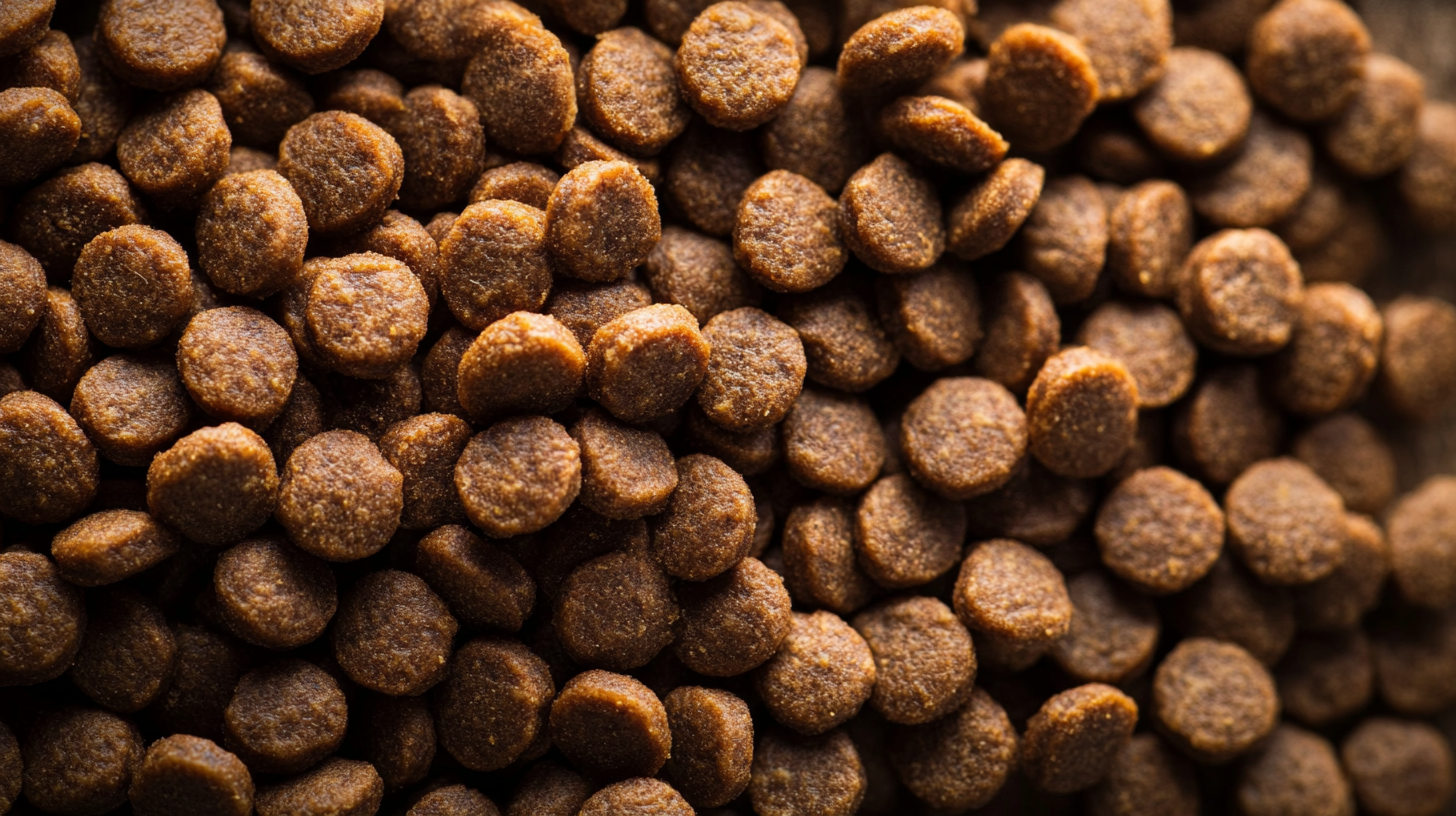When it comes to selecting the best dry dog food for your furry companion, the process can often feel overwhelming due to the multitude of options available on the market. According to the American Pet Products Association (APPA), the pet food industry in the United States reached an impressive value of over $38 billion in 2021, indicating a significant demand for high-quality dog food. As pet owners, we want to provide our "fur babies" with the right nutrition that supports their overall health and well-being. However, not all dry dog food is created equal, making it essential to understand the key factors to consider when making this important decision.
Research from the Association of American Feed Control Officials (AAFCO) emphasizes the importance of choosing a dog food that meets established nutritional standards. Dry dog food must contain a balanced blend of proteins, carbohydrates, fats, vitamins, and minerals to ensure your dog receives the proper nourishment. Understanding your dog's specific needs based on their age, size, and activity level is crucial in guiding your choice. In this blog, we will explore various strategies and tips to help you discern the best dry dog food options that cater to your pet's unique requirements and promote a healthier, happier life.

When selecting the best dry dog food, it’s crucial to understand that a dog's nutritional needs vary significantly based on age and breed. According to the Association of American Feed Control Officials (AAFCO), puppies require a higher protein content—approximately 28% to support their rapid growth and development, while adult dogs typically need about 18% protein in their diet. This fundamental difference highlights the importance of choosing age-appropriate formulations, ensuring that your fur baby receives the right nutrients at critical stages of life. Moreover, certain breeds have unique dietary needs that should be considered as well. For instance, large breed puppies are prone to developmental issues like hip dysplasia, and thus require diet formulations with controlled calcium levels—typically no more than 1.2% to facilitate proper bone growth, as advised by veterinary nutritionists. Conversely, smaller breeds often have higher metabolisms and need food that is higher in fat and calories to maintain their energy levels, underscoring the importance of breed-specific dog food. Recent studies show that tailored nutrition can improve longevity and quality of life for dogs. A study published in the Journal of Animal Science revealed that dogs receiving diets specially formulated for their breed and life stage exhibited improved health markers and weight management. As such, incorporating these aspects into your decision-making can greatly enhance your dog’s well-being, making it essential to consult nutritional guidelines that align with their age and breed characteristics.

When selecting the best dry dog food for your furry companion, a critical step is analyzing the ingredient quality, which can often be deciphered from the dog food label. Pet owners should look for high-quality protein sources as the primary ingredient. According to the Association of American Feed Control Officials (AAFCO), meat meal, such as chicken meal or lamb meal, is considered a more concentrated source of protein than whole meats, providing essential amino acids that support muscle development and overall health.
In addition to protein, pet owners should prioritize whole grains and healthy fats. Ingredients like brown rice and oatmeal offer digestible carbohydrates, contributing to sustained energy levels. The American Kennel Club emphasizes the importance of omega-3 and omega-6 fatty acids found in fish oil and flaxseed, which support a healthy coat and skin, mitigate inflammation, and promote heart health.
Furthermore, avoiding fillers and artificial additives is crucial. Many low-quality dog food brands include by-products, artificial colors, and preservatives that can be harmful over time. Reports from the Pet Food Industry indicate that consumers are increasingly aware of these factors, with 75% of dog owners now reading labels and prioritizing ingredient transparency in their purchasing decisions. By focusing on high-quality ingredients, you can ensure that your canine friend receives a balanced diet that supports their long-term health and vitality.

When selecting the best dry dog food for your beloved pet, it’s crucial to consider the guidelines set forth by the Association of American Feed Control Officials (AAFCO). These standards play a significant role in ensuring the safety and nutritional balance of commercial dog food. AAFCO develops the nutritional profiles that pet food manufacturers must adhere to, which helps to establish a baseline for what constitutes a complete and balanced diet for dogs.
Understanding AAFCO statements on dog food packaging can provide valuable insights into the quality of the product. Look for phrases like “complete and balanced,” which indicate that the formula meets AAFCO's stringent standards for essential nutrients. Furthermore, the AAFCO feeding trials listed on the label suggest that the food has undergone rigorous testing to ensure it supports the health and well-being of dogs. These claims mean that the food has not only been formulated with the right nutrients but has also demonstrated its effectiveness through actual feeding trials.
When browsing different brands, don’t hesitate to familiarize yourself with what the AAFCO standards entail. Doing your research will empower you to make informed choices that benefit your canine companion’s long-term health. It’s also wise to consult with your veterinarian, who can provide personalized recommendations based on your dog’s specific needs, age, breed, and health status, ensuring that you choose a dry dog food that is not just compliant but optimal for your furry family member.

When selecting the best dry dog food for your furry friend, understanding protein sources is crucial, particularly when weighing the benefits of animal versus plant-based proteins. Dogs, as omnivores, generally thrive on diets that include high-quality animal proteins, which are rich in essential amino acids necessary for growth, maintenance, and overall health. Animal proteins, such as chicken, beef, and fish, not only provide these amino acids but also are more easily digestible for dogs compared to many plant sources.
On the other hand, plant-based proteins are increasingly popular in the pet food industry, often marketed as healthier, more sustainable options. While they can be a good source of protein, they typically lack some of the essential amino acids that animal proteins offer. Ingredients like peas, lentils, and soy can contribute to a dog's protein intake, but relying solely on these sources may lead to nutritional deficits. It’s important for pet owners to ensure that the plant proteins included in the dog food are complemented with other ingredients to balance the nutritional profile.
Ultimately, the decision between animal and plant-based proteins should factor in your dog's unique needs, including any allergies, sensitivities, and dietary preferences. Many high-quality dog foods use a combination of both protein types, striking a balance that caters to the nutritional needs of dogs while also catering to the preferences of their owners. Always consult with your veterinarian when making significant changes to your dog’s diet to ensure you are making the best choice for your companion's health and well-being.
When selecting the best dry dog food for your fur baby, it’s crucial to consider allergies and sensitivities that could affect their health and happiness. Many dogs can be sensitive to specific ingredients, which may lead to issues such as skin irritations, digestive problems, or more severe reactions. Identifying these allergens is essential for ensuring your dog thrives on their diet.
Start by researching common allergens in dog food, such as wheat, soy, corn, and certain proteins like chicken or beef. If your dog has exhibited unusual behaviors, like excessive scratching or gastrointestinal upset, it might be time to evaluate their diet closely. Once identified, seek out hypoallergenic dog food options that provide quality nutrition without these irritants. Look for formulas focused on single protein sources or those specifically designed for sensitive stomachs.
Always consult your veterinarian before making significant dietary changes, as they can offer tailored advice based on your dog’s unique needs. Additionally, consider options with limited ingredients and those using novel proteins, such as fish or lamb, which might not provoke sensitivities. By taking these precautions, you can ensure your beloved companion enjoys their meals without discomfort, fostering a happy and healthy life.